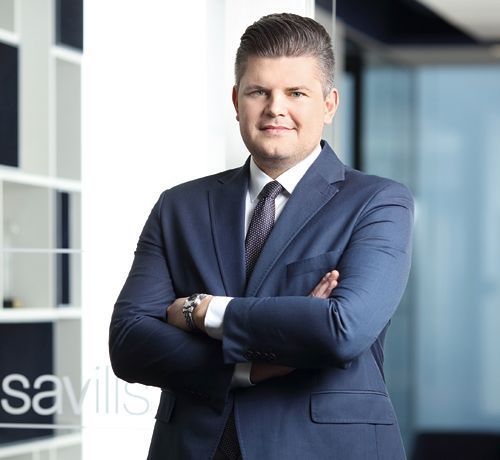Agent of change
Trends
Ewa Andrzejewska ‘Eurobuild Central & Eastern Europe’: Recently there have been changes in the landlord representation division of your office department including your recent promotion and...
Daniel Czarnecki, director, Savills’ office agency, landlord representation: We have in fact decided to strengthen our structures in the regions. Rafał Oprocha is joining us and will be responsible for the Kraków and Wrocław markets, but he will also eventually take care of a third city, Katowice. We have high hopes for these changes. We believe in the development of the regions because the Kraków and Wrocław markets are at a stage of rapid growth and we want to take advantage of this. As far as Poznań is concerned, we have a regional representative there, Piotr Skuza, who knows the local market well and has successfully closed many transactions. In the TriCity, meanwhile, we are seeing the highest demand for consultancy services from tenants, which is being handled by our department led by Jarosław Pilch.
What challenges face you as the new head of the office department?
Our clients – and these are often German funds – need a comprehensive service, including leasing support, if only because their local branches are usually small and focus on asset management. Clients expect the agent to be a partner for them, who will complement their operations on the Polish market. Having a wider perspective of the market is much appreciated. You have to be able to show the way that needs to be taken when devising a leasing strategy. And we know how to do it. The lessons I learned at EY are invaluable here, as well as the consultancy abilities of our entire team.
Several office developers have recently boasted record-breaking results for last year. Is this also being reflected in the achievements of their advisors?
Last year was a record year for the landlord representation team at Savills. We leased more than 80,000 sqm. It was also a good time for developers, especially since the new supply on the market has been balanced by the demand while vacancy is decreasing.
Does the falling vacancy mean that we are shifting from a tenant’s to a landlord’s market where it’s the owners who calls the shots?
So far we can’t generalise, although some micromarkets have certainly been emerging where this is the case. We have noted that this has gradually been the trend in our portfolios, in buildings located in the centre of Warsaw. The supply in the inner centre is low, so tenants don’t have much negotiating strength there. There have also been cases when tenants requiring more than 5,000–6,000 sqm have had problems finding a building with such space, although this situation could change with the increase in supply forecast for the next few years.
The CBD is doing well, but what about the other districts of the capital city?
Some dynamic changes are taken place at the Rondo Daszyńskiego roundabout. Developers are building a great deal there. These include complicated projects such as skyscrapers, which take time to build, so they will only be put into operation in 2019–2020 or even later. Due to this 2018 will be interesting as the balance of power could change in favour of the owners. However, once the new projects come online there will be new activity on the market again. On the other hand, pre-lease negotiations are already underway, so we may see a situation in which some of these facilities will be virtually fully leased before the construction is completed. There have been many inquiries for large areas, so the demand certainly exists for new buildings.
Last year Savills published a report on Służewiec, a district sardonically referred to as ‘Mordor’ by many people. But you actually praise this district in your reports. Is the area around Rondo Daszyńskiego in the Wola-Centre district now not set to become another ‘Mordor’?
The Daszyńskiego roundabout differs from Służewiec in terms of infrastructure and space for its development. Nothing will change in this respect near the roundabout. What has already been built, such as the underground, will have to handle an increasing number of people. However, the development of infrastructure in Mokotów is still in progress. The city has ideas on how to improve things, such as a new tram line from Dworzec Wileński on the other side of the river and a plan to connect ul. Żwirki i Wigury with ul. Woronicza. Ul. Marynarska itself is also being improved and this should clear the road traffic in Mokotów. A number of public associations and initiatives have been set up, including Lepszy Służewiec [A Better Służewiec], and the district itself has been changing from an office to a multifunctional one – hotels and apartments are being developed while retail and services are now open after 5 pm. The myth that has grown up about the district – that it dies after working hours – is no longer a fair one.
Is it easier to lease out a new building in Służewiec – or one that is already established in the district?
You always need to actively seek out tenants in Mokotów, but expansions within the same building are the exceptions. Taking the D48 building, which we are the exclusive agent of, as an example, you can discover that sometimes tenants who see a new, beautiful project don’t realise that the rent rates in it could be within their capabilities. It was the sheer newness of the building that had deterred them. Obviously, starting rents and effective rents are two different things, because you need to take into account the energy efficiency of new projects, the space efficiency – sometimes a new project can be about 10–12 pct more efficient than an older one – and the operating fees. The package for a tenant occupying more than 1,000 sqm in a new building is often more attractive. Older buildings, however, remain a challenge – sometimes you need to find a new angle for them.
If not by the price, then how can you attract tenants?
The marketing strategy for the building is of key importance. People who decide to lease an office for five or more years must feel connected to the building. For example, when drawing up the strategy for D48 we decided that there had to be retail and service areas in the building that would be open after business hours, as well as green zones. Another important factor are the parking facilities for guests, which are often lacking in this location – at D48 there is room for 45 cars. We also emphasised the importance of the lobby, which is not only the showcase of the office building but can be used for informal meetings. All these activities have had a positive impact on the leasing, because the building is more than 80 pct occupied just a few months after coming into use. We are also not afraid of taking on the challenge of re-commercialising buildings that have been in use for a long time. By positioning the property in the right way, renovating the common areas, the toilets, the façade and installing modern systems, tenants can feel much more comfortable in such a building. We often recommend such an approach when re-commercialising buildings.
Finally – last year finally saw co-working taking off.
Warsaw is a great place for companies that are undergoing rapid growth – and some of these are even expanding every few months. You have to remember that there are more and more firms like this. However, co-working and serviced offices are not only places for start-ups but also provide flexible space for large corporations with teams working on short-term projects. It’s true that many companies have recently emerged that now offer this type or similar space, but this is still very small-scale compared to the more developed markets of Western Europe.
Flexible office space
Flexible office space continues to gain in popularity in Warsaw. According to Savills, almost 95,000 sqm of flexible office space is now available in the city, out of which over a half is situated in serviced offices (53,000 sqm), while the rest is co-working space (42,000 sqm). In total flexible offices are offered in 105 locations, most of which is co-working space (65 locations). The serviced office market is relatively consolidated and the operators are usually professional companies. On the other hand, the co-working market is rather fragmented, with several private owners; however, big international players are now entering the market. Even serviced office giant Regus has now decided to launch a co-working brand, Spaces. The take-up generated by flexible office providers in 2017 doubled in comparison to 2016, reaching 31,000 sqm (4 pct of total office take-up in Warsaw). The largest transactions include a new lease by Spaces in Centrum Marszałkowska (4,200 sqm) as well as New Work in Wilanów Office Park (3,100 sqm). “2017 was undoubtedly when co-working finally took off. There is nothing to suggest that its expansion will slow down in the near future. The development of the flexible workplaces market is now so dynamic that some of the risks involved have begun to be taken on board. In Poland, however, there is still room for many new operators or for the expansion of existing ones, provided that this is done in a sustainable manner and properly distributed over time. There are still regions that seem to have been overlooked by operators where we can see much potential. I expect a significant increase in cities outside Warsaw this and next year, but due to the possibility of the rapid saturation of markets in smaller cities the first come, first served rule might apply here,” comments Jarosław Pilch, the head of the tenant representation in Savills’ office agency.






















































